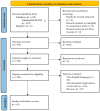Current Role of Artificial Intelligence in the Management of Esophageal Cancer
- PMID: 40142652
- PMCID: PMC11943403
- DOI: 10.3390/jcm14061845
Current Role of Artificial Intelligence in the Management of Esophageal Cancer
Abstract
Background/Objectives: Esophageal cancer (EC) represents a major global contributor to cancer-related mortality. The advent of artificial intelligence (AI), including machine learning, deep learning, and radiomics, holds promise for enhancing treatment decisions and predicting outcomes. The aim of this review is to present an overview of the current landscape and future perspectives of AI in the management of EC. Methods: A literature search was performed on MEDLINE using the following keywords: "Artificial Intelligence", "Esophageal cancer", "Barrett's esophagus", "Esophageal Adenocarcinoma", and "Esophageal Squamous cell carcinoma". All titles and abstracts were screened; the results included 41 studies. Results: Over the past five years, the number of studies focusing on the application of AI to the treatment and prognosis of EC has surged, leveraging increasingly larger datasets with external validation. The simultaneous incorporation in AI models of clinical factors and features from several imaging modalities displays improved predictive performance, which may enhance patient outcomes, based on direct personalized therapeutic options. However, clinicians and researchers must address existing limitations, conduct randomized controlled trials, and consider the ethical and legal aspects that arise to establish AI as a standard decision-support tool. Conclusions: AI applications may result in substantial advances in EC management, heralding a new era. Considering the complexity of EC as a clinical entity, the evolving potential of AI is anticipated to ameliorate patients' quality of life and survival rates.
Keywords: artificial intelligence; diagnosis; esophageal cancer; prognosis; treatment.
Conflict of interest statement
The authors declare no conflicts of interest.
Figures
References
-
- Collaborators CBDOC The global, regional, and national burden of oesophageal cancer and its attributable risk factors in 195 countries and territories, 1990–2017: A systematic analysis for the global burden of disease study 2017. Lancet Gastroenterol. Hepatol. 2020;5:582–597. doi: 10.1016/S2468-1253(20)30007-8. - DOI - PMC - PubMed
-
- American Cancer Society . Cancer Facts & Figures 2024. American Cancer Society; Atlanta, GA, USA: 2024.
-
- Global Burden of Disease Cancer Collaboration. Fitzmaurice C., Allen C., Barber R.M., Barregard L., Bhutta Z.A., Brenner H., Dicker D.J., Chimed-Orchir O., Dandona R., et al. Global, Regional, and National Cancer Incidence, Mortality, Years of Life Lost, Years Lived With Disability, and Disability-Adjusted Life-years for 32 Cancer Groups, 1990 to 2015: A Systematic Analysis for the Global Burden of Disease Study. JAMA Oncol. 2017;3:524–548. doi: 10.1001/jamaoncol.2017.0098. Erratum in JAMA Oncol. 2017, 3, 418. - DOI - PMC - PubMed
Publication types
LinkOut - more resources
Full Text Sources
Miscellaneous


